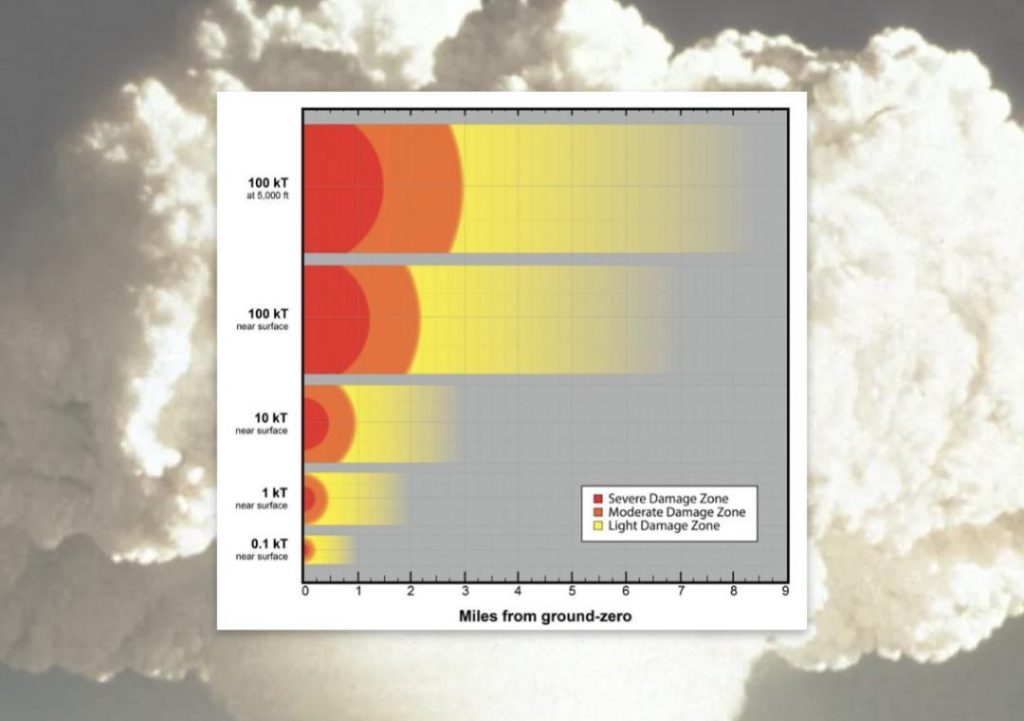
How Far Away Does One Have to Be to Survive a Nuclear Bomb?
The threat of nuclear war is always looming, and it’s essential to understand the risks and consequences of a nuclear explosion. When a nuclear bomb detonates, it releases an enormous amount of energy in the form of heat, light, and radiation. The distance from the epicenter of the explosion, known as ground zero, determines the severity of the damage and the likelihood of survival. In this blog post, we’ll explore the effects of a moderate 10-20 kiloton nuclear explosion and the distance from ground zero that makes survival more or less likely.
Immediate Effects: Heat and Radiation
The immediate effects of a nuclear explosion are devastating. The blast wave from the explosion can cause widespread destruction, including structural damage to buildings and infrastructure. However, it’s the heat and radiation that pose the greatest threat to human life.
The thermal radiation, also known as the heat pulse, can cause severe burns and start fires. The intensity of the heat pulse decreases with distance from the epicenter, but it can still cause significant damage even at a distance of several kilometers.
The radiation released by a nuclear explosion is a much greater concern. There are two types of radiation: gamma radiation and neutron radiation. Gamma radiation is the most dangerous, as it can penetrate solid objects and cause damage to living tissues. Neutron radiation, on the other hand, is more limited in its range but can still cause significant damage.
Survival Distance: A Guide to Radiation Exposure
To understand the distance from ground zero that makes survival more or less likely, we can look to the guidelines provided by Radiation Emergency Medical Management (REMM). According to REMM, for a moderate 10-20 kiloton explosion:
- Within 0.8 km (0.5 miles) of ground zero, survival is unlikely due to lethal heat and radiation.
- At 1.6-3.2 km (1-2 miles), radiation exposure is survivable with prompt medical care.
- Beyond 6.4 km (4 miles), radiation risk is minimal.
These guidelines are based on the expected radiation exposure and the likelihood of survival with or without medical treatment. However, it’s essential to note that these distances are estimates and can vary depending on the specific circumstances of the explosion.
Factors Affecting Survival
Several factors can affect the distance from ground zero that makes survival more or less likely. These include:
- The size and type of nuclear weapon: Larger weapons release more energy and radiation, increasing the distance from ground zero that is affected.
- The altitude of the explosion: Explosions at higher altitudes release more radiation and can affect a larger area.
- The terrain and weather: Hills, valleys, and weather conditions can affect the direction and intensity of the radiation.
Conclusion
Surviving a nuclear bomb is a complex and challenging task. The distance from ground zero is just one factor that determines the likelihood of survival, and it’s essential to consider the other factors mentioned above. By understanding the effects of a nuclear explosion and the distance from ground zero that makes survival more or less likely, we can take steps to prepare and mitigate the damage.
Source:
Radiation Emergency Medical Management (REMM). (n.d.). Zones of Nuclear Detonation. Retrieved from https://remm.hhs.gov/zones_nucleardetonation.htm
Note: The information provided in this blog post is based on the guidelines and estimates provided by Radiation Emergency Medical Management (REMM). While these guidelines are intended to provide general information, they should not be relied upon as medical advice. In the event of a nuclear emergency, it’s essential to follow the instructions of local authorities and medical professionals.






